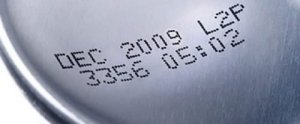How Important is the Expiration Date on Foods?


Reviewed and approved by Doctor Carlos Fabián Avila
Sometimes, we give the expiration date the importance it deserves. Other times, however, we don’t pay enough attention to it.
However, the truth of the matter is that expiration dates are important.
In this article, we’re going to tell you everything you need to know about them and how to know when you can eat foods that have gone past their expiration date.
What’s an expiration date for?
An expiration date is in charge of measuring the shelf life of a food. In other words, it’s a number that tells you the time between its creation and deterioration.
It also takes into account several factors like temperature, light, and oxygen. This is because these can make the date change.
A food can suffer from several kinds of expiration. No matter what, all of them need to be controlled through conservation techniques. This includes things like refrigeration or freezing.
This way, your food can remain in a good state for a longer period of time.
No matter what, this date is important. This is especially true if foods are more perishable. After all, these have a higher risk of contaminating your health. This is the especially case for dairy and meat.
You may not be aware of this, but there are foods that must be labeled with an expiration date or a “best if used by” date by law.
Among them, we can find wine and alcoholic beverages with more than 10% by volume. Even though it’s true that the passage of time can make these products deteriorate, in this case, it doesn’t pose any health risk.
How to find the expiration date on foods

Expiration dates aren’t used the same way for all foods. Actually, it appears in several ways:
- Foods that can’t be kept for more than three months should say “best if used by” or “expiration date”on their packaging. This should be followed by the month and the day.
- However, if you can keep the food more than three months, it should show the month along with the year.
- If you can store products for more than 18 months, they need to indicate the year that they expire.
What happens to food that is past its expiration date?
First of all, the quality of the product gets worse as it spends more time on the shelf.
This may be due to many things, including:
- Change in temperature
- Physical transference of substances to the food like oxygen, smells, and colors
- Changes due to sun exposure
If you want to know the shelf life of a food better, you’ll have to see if these changes have started to appear in the food. Ultimately, you’ll see if it’s deteriorating in storage.
Take care of the temperature of products

Next, there’s something you need to keep in mind in regards to storage: the temperature of the products.
If they experience a quick increase or change in temperature, you could have problems with your food safety.
The more time and higher the temperature, the greater the contamination.
Microorganisms can grow rapidly between 40 °F and 160°F. If this happens, your food may be completely contaminated in a matter of hours.
In addition, another aspect you need to be especially careful of is the food thawing process. After all, you can start expose food to bacterial contamination if you don’t do this process correctly.
To avoid this, all you have to do is make sure to properly store food:
- Manage its storage temperature. This ensures that pathogenic microorganisms won’t reproduce.
- The maximum temperature for foods varies between 35.5 °F and 43°F.
All cited sources were thoroughly reviewed by our team to ensure their quality, reliability, currency, and validity. The bibliography of this article was considered reliable and of academic or scientific accuracy.
- Gast RK., Regmi P., Guraya R., Jones DR., Anderson KE., Karcher DM., Contamination of eggs by salmonella enteriditis in experimientally infected laying hens of four commercial genetic lines in conventional cages and enriched colony housing. Poult Sci, 2019. 98 (10): 5023-5027.
- Camp MJ., Shipley LA., Milling CR., Rachlow JL., et al., Interacting effects of ambient temperature and food quality on the foraging ecology of small mammalian herbivores. J Therm Biol, 2018. 71: 83-90.
This text is provided for informational purposes only and does not replace consultation with a professional. If in doubt, consult your specialist.








